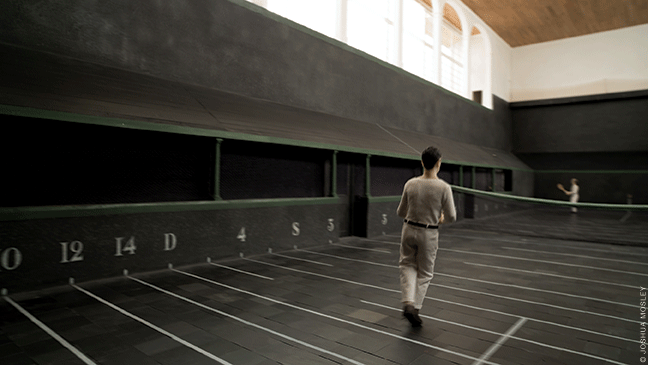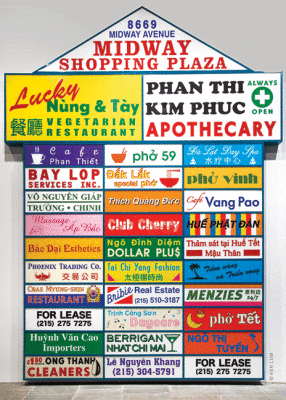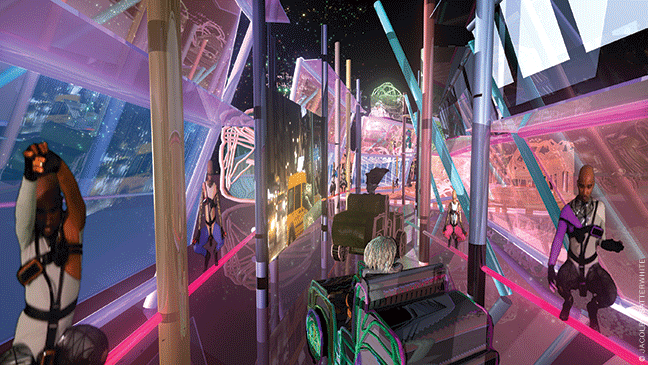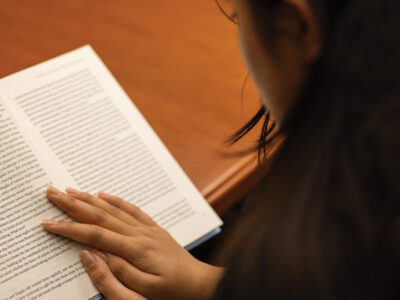
Jeu de Paume, Joshua Mosley
On the fourth floor of the Whitney Museum of American Art, just one level below Georgia O’Keeffe’s flowers, Roy Lichtenstein’s pop art, and Alexander Calder’s mobiles, a tennis match is underway.
The court surface is strange, nothing like the US Open’s green-and-blue hardcourt or even Wimbledon’s grass. It’s made of black tiles and framed by black walls with white numbers and letters painted at the bottom. The only evidence of Open-style tennis is the customary net and the racquet in each man’s hands.
There’s a sizable crowd inside the Whitney watching every forehand, backhand, and serve. A tall guy with shaggy blond hair chuckles when one player hits the ball into a netted window. Others viewers simply stare, poker-faced, as Ferdinand Garcin and J.B. Gribble whack the ball back and forth on this odd, asymmetrical indoor court.
Joshua Mosley, professor and chair of the University’s fine-arts department, orchestrated every moment of this “court tennis” match: the squeaking shoes and shuffling players, the popping sound when a ball hits a racket, the light pouring in through big lofted windows. They’re all part of Mosley’s three-minute stop-motion animation, Jeu de Paume (“palm game”)—one of several hundred works on view through May 25 at the Whitney Biennial.
The renowned biannual survey exhibition spotlights contemporary American artists, hoisting their work onto a high-profile Manhattan stage. Emerging artists have both broken out and fizzled out as a result of the show. If the chances of being invited to exhibit are slim, the odds of four of the 103 biennial artists this year—and one of its three curators—having close ties to a certain West Philadelphia university are downright minuscule. Yet there they are, scattered throughout the catalogue: Mosley, fine-arts professor Ken Lum, PennDesign alumnus Jacolby Satterwhite GFA’10, the late Terry Adkins (a fine-arts professor who passed away in February), and Anthony Elms, associate curator at the Institute of Contemporary Art.
As a new twist this year, exhibition officials asked three outside curators to present three independent visions, one on each floor of the museum.
“It’s significant that we’re all in the biennial at all,” Mosley says of himself and his PennDesign colleagues, “but then on top of that, there’s the fact that the exhibition is three different views of what’s happening in contemporary art, and all three views include at least one person associated with the Penn fine-arts program. That’s pretty terrific, and I also think it shows the breadth of our program.”
“Of course it’s good for the program,” adds Lum, who directs the undergraduate fine-arts program. “It highlights it as relevant and recognizes at the highest level that the Penn program is connected with the issues of leading contemporary art.”
Michelle Grabner, a Chicago-based artist and professor who curated the fourth-floor vision, says PennDesign has “perhaps the strongest interdisciplinary studio-arts program in the country,” one that “underscores theory as well as practice.” In her sprawling fourth-floor domain, she exhibited Mosley’s tennis animation on a large flat-screen TV and also displayed a large work by Lum.

Midway Shopping Plaza, Ken Lum
Stretching from floor to ceiling of an entire gallery wall, Lum’s Midway Shopping Plaza (2014) may be familiar to the South Philly-savvy. It’s closely modeled on a sign for the New World Plaza, a Vietnamese shopping center at Sixth Street and Washington Avenue. Lum’s work replaces listings for Saigon Maxim restaurant, Pho Ha, and other shops and eateries with names, battles, and events from the Vietnam War. The brightly colored sign looks so authentic—as though it could have been yanked from an actual strip mall—that one hears an unbroken stream of Whitney visitors announcing, “It’s all Vietnam War references!” after reading the wall text beside the piece. Yet the Canadian-born Lum, who’s of Chinese heritage, says he was “interested in not just dwelling on the trauma of war” in Midway. He also wanted to celebrate the Vietnamese immigrants who arrived in America after the war and forged “a new identity and a new community” in South Philly, illustrated by “this dynamic shopping center.”
Lum has been making signage-inspired artworks since the 1980s and is in the midst of a “mini-mall series.” As he explains in the Whitney Biennial audio tour: “I often ask myself, who the people are behind each of these shops? … I also think about how [one of these signs] breaks all the rules of proper, so-called ‘good’ design because it’s so cacophonous. It transcends the question of taste. These slats representing each shop have to embody a lot of information.”
Grabner calls Midway Shopping Plaza “graphically seductive” and says it’s “the critical anchor to one of my main galleries.” She’s also quick to praise Mosley’s work, which hangs in a smaller gallery several rooms over. “Jeu de Paume is a masterful technical achievement,” she says. “Its accuracy and abstractions combine to make one of the most mesmerizing works on view in the 2014 biennial.”
On a mid-March visit to the show, Mosley’s gallery had a consistently large group of people in it, many staying for two or three viewings, eyes glued to the animated tennis match. Mosley says the work is set in 1907 France at the Chateau Fountainbleu tennis court. Using two historical players for inspiration, he created silicone puppets, dressed them in cloth garb, and plunked them onto a 15-foot-long tennis court.
“Then there’s another element to the piece,” he says. “Before I ever moved the puppets, I held the camera on my shoulder and performed the camera movements as if I was filming a tennis player: running in, running out, readjusting. Then I scaled that motion down to the scale of my puppets and sent it out to a robot that moved the camera frame-by-frame while I would move the puppets. What you see in the show looks like the movement of someone holding the camera, but it’s actually this process of performing it with my body, shrinking it down, then having a robot repeat my motion on a small scale.”
He worked on the animation for three years, producing about one second of video for each day of work. “It’s probably the most technically difficult piece I’ve done,” he adds. “As far as I know, this is the first time someone has made a stop-motion animation with a handheld camera. But I don’t think the industry will steal the idea because it’s so impractical. There’s something very unique about that.”
Jeu resonated with critics. Time Out New York called it “charming,” while a GalleristNY reviewer described it as a “gem,” adding: “Again and again you will yearn for more.”

Transit, Jacolby Satterwhite
A piece by Satterwhite, one of Mosley’s former students, hangs in the Whitney just one floor down from Jeu de Paume. It’s one of the first works visitors encounter on the biennial’s third floor. Selected by curator Stuart Comer, Satterwhite’s Reifying Desire 6—Island of Treasure (2014) also plays on a flat-screen TV, but comparisons to Mosley’s work end there. While Mosley set out to create a realistic tennis match using puppets, Satterwhite aimed for “a distorted simulacrum of reality,” as he explains on his website. His hypnotic 3-D video fuses animated objects and backgrounds with live-action dance and movement performed by Satterwhite himself. Clad in a spandex unitard, he moves and vogues in both real and imaginary scenes, from a park stream to the streets of New York to something resembling the inside of a spaceship.
“It was exciting to see him at the opening,” Mosley says of Satterwhite, “because I’d worked with him on earlier iterations of the same project. He took my animation class at Penn. His piece was basically born in the animation lab of Addams Hall.”

Avarium, Terry Adkins
Mosley created Jeu de Paume in Addams Hall, too, often soliciting help and feedback from his graduate students. He notes that Adkins, the late fine-arts professor, also carried out much of his research and design process at Penn. His five Avarium sculptures stretch across a full gallery wall in the Whitney. They’re static, 3-D representations of bird songs—sound waves translated into silver-plated brass cymbals, steel, and aluminum. The silent works hover several feet above visitors’ heads, jutting from the gallery wall at a height that brings to mind a singing bird perched in a tree.
“Terry was extremely excited about the number of things that were happening with his work,” Mosley says. “He felt like there was a lot of support for his work and he felt liberated to work faster and more confidently. It was great to see his work at the biennial opening because it still had that energy.”
Adkins was “a good maker who’d been working in the trenches for a long time and was slowly beginning to get his due,” says Elms, explaining why he chose him for his second-floor domain. As one of three Whitney Biennial curators, Elms has had a hectic, high-pressure year-and-a-half. He had until last summer to figure out which artists to present and which of their pieces to include. The biennial, he says, is “an attempt to say, ‘This is where we are’ in American art right now.”
“In a way,” Lum notes, “the biennial is a curator’s show as much as what the artists contribute. People are always trying to theorize what the curatorial intentions were.”
Elms says his goal was to “find the vision from the artists I was interested in, rather than the other way around,” adding: “I became interested in people who were really attuned to working with materials that are around them,” and in “people who slide between media and have an interest in words and voices.”
“Given the sprawl, assembling an overview of American art these days is a fool’s errand,” he wrote in his biennial catalog essay. The 24 artists and groups assembled, he noted, could be described as “We who ‘love to be astonished.’”
In decades past, the biennial was a show critics loved to hate, or perhaps hated to love. Reviews of this year’s edition were still coming in at press time. Holland Cotter in The New York Times described it as “a large, three-tiered cake of a show, mostly vanilla, but laced with threads of darker, sharper flavor, and with a lot of frosting on top.” New York magazine critic Jerry Saltz had a harsher take, calling the show “optically starved, aesthetically buttoned-up, pedantic.”
Elms went into his role as curator fully aware of the potential criticism. “You can’t let that weigh on what you’re going to choose,” he says. “I knew the chances of anybody liking the show were kind of slim because people are always ready to come to it with their own pre-conceived notions of what it should be. But you can’t plan a show hoping for the good reviews. You have to plan it making the right decisions.”




